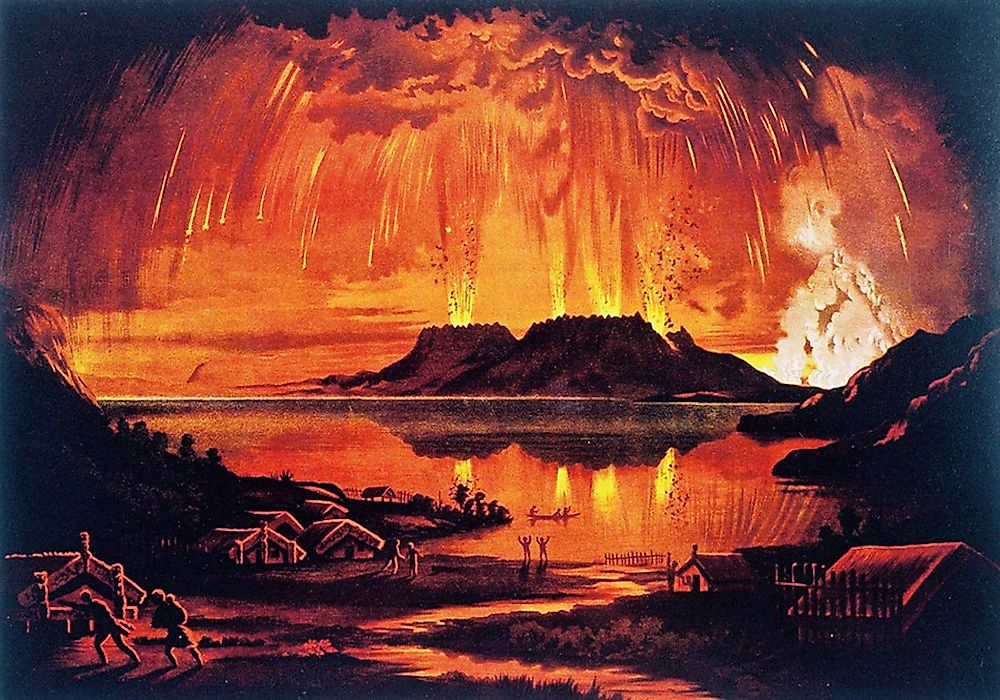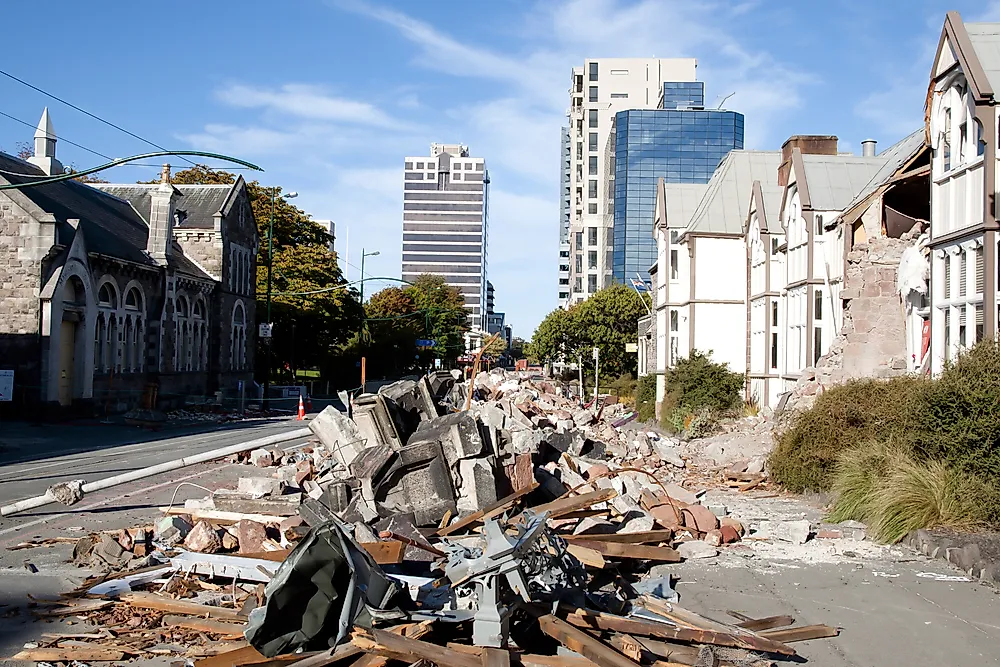New Zealand's Deadliest Disasters Ever

New Zealand has experienced hundreds of disasters that have led to the loss of several lives, tens of thousands of injuries, and damages to properties. The disasters range from pandemic heath crises to natural and human-made disasters. Most of the disasters have been caused naturally by elements such as earthquakes, tsunamis, and landslides. The Air New Zealand Flight TE901 Crash is the worst disaster to have been experienced in the country apart from the 1918 flue pandemic. While some of the disasters would have been avoided or even the number of casualties reduced, the slow response and lack of preparedness led to significant casualties. Some of the dead bodies in a number of disasters are yet to be recovered.
10. Mount Tarawera eruption
Mount Tarawera is a volcano located on the country's North Island. It consists of a series of rhyolitic lava domes. On June 10, 1886, a series of 30 increasingly strong earthquakes characterized the area of Rotorua accompanied by an unusual sheet lightning from the direction of Mount Tarawera at around midnight. At around 2 a.m., the areas experienced a larger earthquake accompanied by the sound of an explosion. Mount Tarawera’s three peaks erupted at around 2:30 a.m., blasting smoke and ash thousands of miles into the sky. However, the worst was even yet to come. The largest phase of eruption commenced an hour later with the vents at Rotomahana producing pyroclastic surge that flowed for about 17 kilometers and destroyed several villages. The death toll was initially estimated at 153 but only 108 people could be identified as killed by the eruption. The number was later reviewed to 120 deaths at most.
9. SS Wairarapa shipwreck
The SS Wairarapa was a New Zealand ship that frequented the route between Auckland, New Zealand, and Australia in the 19th century. It was built in Scotland in 1882 as a luxury steamer. On October 24, 1894, it sailed from Sydney towards New Zealand. Four days later, fog and storms set in as it rounded the top of North Island. However, the captain of the ship refused to slow the ship's speed, even despite the thick fog. The ship could not stay on course, possibly due to a faulty compass. A few minutes past midnight on October 29, 1894, the SS Wairarapa was wrecked on a steep cliff near the tip of the Great Barrier Island leading to 121 deaths.
8. SS Tararua shipwreck
SS Tararua was a screw-driven steamer who had two horsepower engines. It was built in Dundee in 1864 and had a capacity of 523 tons, which was later increased to 563 tons. On April 28, 1881, the ship set out from Port Chalmers in the direction of Melbourne. At around 4 a.m., the captain turned the ship west believing he had cleared the southernmost point. An hour later, the ship struck Otara Reef. A lifeboat launched into the water and carried a volunteer close to the shores who raised an alarm. However, the help was delayed. Several people who attempted to swim to the shores did not make it because of strong waves. SS Tararua took 20 hours to sink with the wreckage disappearing overnight. About 131 people perished in the disaster of which 55 were buried in a nearby plot.
7. 1st Little Waihi landslide
Little Waihi, officially known as Waihi Village, is a small Maori community made up of around 25 households. It is located on the southwestern shores of Lake Taupo, New Zealand. The village has been a site for three major landslides in 1910, 1846, and 1780 with approximately 200 people perishing in total. In 1780, an unusually long rainy season occasioned a landslip on the mountain, damming a stream which burst its barriers. The avalanche of debris swept and buried the Te Rapa with only a few people managing to escape. Several houses, rocks, and trees were swept into the lake while over 135 people were killed by the avalanche of debris.
6. Tangiwai disaster
The Tangiwai disaster took place on Christmas Eve, 1953, when the Bridge of the Whangaehu River collapsed beneath a passenger train that had been en route from Wellington to Auckland. The locomotive was made up of 11 carriages and had 285 passengers and crew on board. The train passed through Tangiwai Station at about 10 p.m. Upon approaching the Whangaehu River's bridge, the conductor slammed on the brakes in response to a passerby who stood on the track waving a torch (other accounts insist that the brakes were slammed on account of the perceived poor condition of the bridge). The train was hauled into the river with only the three first-class carriages and two vans remaining on track. 151 people including 149 passengers, the engine driver and a fireman perished. Twenty bodies were never found and were presumed to have been carried down to the ocean.
5. 2011 Christchurch earthquake
Christchurch was the site of an earthquake on February 22, 2011. It registered as 6.3 on the Richter scale. The earthquake occurred around the Canterbury Region on New Zealand's South Island and caused widespread damage across the city of Christchurch. The earthquake killed about 185 people and damaged many properties. The central city was badly affected, where the infrastructure had already been weakened by the previous year’s earthquake. Half of the deaths during the earthquake occurred at the Canterbury Television Building which collapsed and caught fire. Other people died in the collapse of PGC House while the rest died when a building collapsed on a bus along the Colombo Street. Over 6,500 people were treated for minor injuries while 200 were treated for major trauma.
4. HMS Orpheus shipwreck

HMS Orpheus was a Royal Navy corvette that was a flagship of the Australian squadron. It was built in 1861 in Kent, England. The ship left Sydney on January 31, 1863, en route to Manukau Harbor. It ran through series of dangerous sand bars. As it approached the submerged bars, a signal was received from the Paratutae Island instructing the ship to turn north to avoid grounding. Despite the captain's attempt to correct the course, the ship hit the bar, causing it to swing around and exposing its port side to the wave. The hatches burst open and Orpheus began taking in water. The sea power made escape extremely difficult sweeping many sailors away leading to the death of 189 people.
3. 1820s Southland tsunami
New Zealand is part of the geologically active Pacific Plate, where tsunamis can occur. The tsunamis affect the country’s coastline frequently and are often caused by earthquakes on the Pacific Plate. New Zealand is affected by the tsunami of a magnitude greater than one meter every ten years on average. In the 1820s, several people were killed by a tsunami while strolling along the beach near the Orepuki. The people were gathering fish at the mouth of Waiau River as a provision for the winter period. The exact date for the tsunami is not known, but it could have been caused by an earthquake on the Fiordland. 1820s Southland tsunami is estimated to have caused over 200 deaths.
2. 1931 Hawke's Bay earthquake
Hawke's Bay earthquake took place on February 3, 1931, leading to the death of about 256 people and causing injuries to thousands of people. The earthquake also caused a devastating damage to the Hawke’s Bay region with hundreds of buildings and properties destroyed. The earthquake lasted 150 seconds and measured a magnitude of 7.8. All buildings in the central area of Napier and Hasting were brought down, while the landscape of the area changed drastically. A fire broke out in a nearby chemist and at a nearby hotel. Several aftershocks were also recorded in the area which caused a varying degree of damages. 1931 Hawke's Bay earthquake is the deadliest in the history of New Zealand.
1. Air New Zealand Flight TE901 Crash
Air New Zealand Flight TE901 operated between 1977 and 1978. It was a scheduled sightseeing flight over the Antarctic. The flight would leave Auckland in the morning and fly for the whole day over the Antarctic. On November 28, 1979, the plane crashed into Mount Erebus, killing all the 257 people including 20 crew members and 237 passengers. The accident was initially blamed on pilot error. However, a Royal Commission of Inquiry had to be formed after public outcry concluded that the accident was as a result of the corrections made to the flight coordinate the night before the accident. The crew had never been informed of the changes.
New Zealand's Deadliest Disasters Ever
| Rank | Disaster | Date | Death Toll |
|---|---|---|---|
| 1 | Air New Zealand Flight TE901 Crash | 28 Nov 1979 | 257 |
| 2 | 1931 Hawke's Bay earthquake | 3 Feb 1931 | 256 |
| 3 | 1820s Southland tsunami | 1820s | 200+ |
| 4 | HMS Orpheus shipwreck | 7 Feb 1863 | 189 |
| 5 | 2011 Christchurch earthquake | 22 February 2011 | 185 |
| 6 | Tangiwai disaster | 24 Dec 1953 | 151 |
| 7 | 1st Little Waihi landslide | 1780 | 135+ |
| 8 | SS Tararua shipwreck | 29 Apr 1881 | 131 |
| 9 | SS Wairarapa shipwreck | 29 Oct 1894 | 121 |
| 10 | Mount Tarawera eruption | 10 Jun 1886 | 108–153 |











